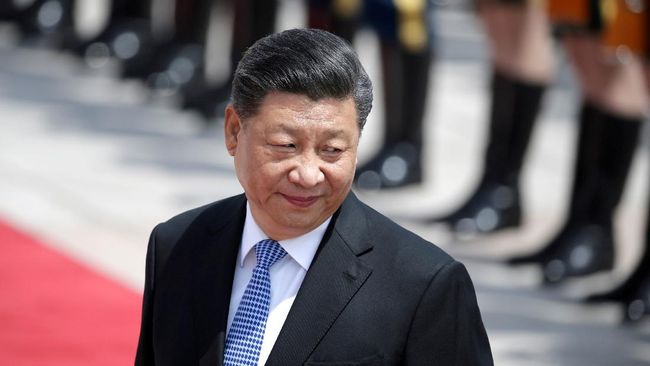Jakarta, CNBC Indonesia – Since the Covid-19 pandemic, China’s fate does not seem to be going smoothly. Because many crises hit the Bamboo Curtain State in a row.
So, what are the crises that hit China?
One of the crises that is currently haunting China is the electricity crisis, which is rumored to be getting more widespread since a few months ago. This crisis occurred because of the accumulation of a number of problems.
China lacks coal, which dominates 70% of its electricity sources. This comes after record high fuel prices, as well as post-pandemic industrial demand that has increased as the push to use more environmentally friendly industries.
The electricity crisis in China did not burden households, but it also caused production disruptions in many factories. Nearly 20 regions of the country experienced blackouts in nearly 20 regions.
Soaring energy prices had implications for producer prices rising to their highest level in at least 25 years in September. Last week, prices rose 10.7% from a year earlier.
In addition, the coming winter is also likely to worsen the situation. The China Meteorological Center expects strong winds to bring the average temperature down to 14 degrees Celsius this week.
Temperatures in northern China, for example, have fallen below normal. This further increases the demand for heating in the midst of the electricity crisis.
The three northeastern provinces of Jilin, Heilongjiang and Liaoning, which are currently also short of electricity, have also started using heating for the winter. The same is true for the provinces of Inner Mongolia and Gansu, which rely on coal-fired power plants to cope with colder-than-usual weather.
In fact, the Beijing government is said to have started taking a number of steps to contain the increase in coal prices and increase production. The government has also implemented electricity rationing in factories.
China is said to have approved 153 new mines to increase capacity. The country hopes to increase the supply of up to 55 million tons of troops in the fourth quarter of 2021. Unfortunately, as many as 60 coal mines are reported to have sunk.
In addition to the electricity crisis, China is also expected to experience stagflation. This slowing economy but high inflation is known as stagflation and has become a ‘nightmare’ for China, because economic actors have to pay dearly for mediocre economic growth.
The limited supply of raw materials, labor, plus the energy crisis has made production costs swell in China.
China’s Producer Price Index (PPI) also jumped sharply. In September 2021, China’s PPI reached 10.7% compared to the same period the previous year (year-on-year/yoy). This is the highest record since at least 1996.
When inflationary pressures begin to be felt, the economy’s output slows down. This can be seen from manufacturing activity as reflected by the Purchasing Managers’ Index (PMI).
China’s National Bureau of Statistics (NBS) reported that the manufacturing PMI for the October 2021 period was 49.2, down from 49.6 in the previous month, as well as being the lowest since February 2020.
Please note, PMI uses the number 50 as a starting point. Below 50 means the business world is in a phase, there is no expansion.
In fact, manufacturing in China has a very vital role for the economy. In the last 10 years, on average this sector contributed 29.06% in the formation of Gross Domestic Product.
Signs of stagflation are increasingly visible in China. Prices of goods in the country continued to rise while manufacturing data showed production slowed.
In addition, the new wave of Covid-19 due to the Delta variant in China is also spreading. At least, since the tourist cluster was discovered October 17, until Sunday (11/14/2021) there have been 1,308 local cases detected by the Bamboo Curtain government.
Quoting Reuters, this is a record when compared to the wave that appeared last summer in Nanjing, July 2021. At that time, the number of related cases was 1,280.
In the latest update, Covid has also spread in 21 provinces. Most recently, Covid-19 is now endemic in the city of Dahlian, Liaoning Province.
Since the first locally symptomatic patient in Dalian from the most recent outbreak was reported on Nov. 4, the port city of 7.5 million people has detected an average of about 24 new local cases a day. This number is more than any other Chinese city.
This also made the nearby cities of Dandong, Anshan and Shenyang take special policies on those coming from Dalian. They must be quarantined in a centralized facility for 14 days.
Dalian is a shipping gateway for seafood as well as fruits and some meats. Due to Covid-19, the government has also asked all businesses that handle imported cold and frozen food to suspend operations.
So far, mainland China has reported a total of 98,368 confirmed cases of coronavirus with symptoms, including infections transmitted within the country and those from abroad. While there were 4,636 deaths.
Will the China crisis affect Indonesia?
Indonesia is currently still very dependent on Chinese products, especially raw materials. It is undeniable that the raw material crisis will be the next problem, if the panda country cannot answer the demand because of the energy crisis. One of the sectors affected is the footwear industry.
Executive Director of the Indonesian Shoe Association (Aprisindo) Firman Bakrie said 60% of the raw materials for footwear can be produced domestically, while the rest still depend on China, Vietnam and Europe. However, he admits that the current conditions make it difficult for business actors to find raw materials.
“When there was an energy crisis, and the second wave of COVID-19, we started to have a shortage of raw materials. Likewise from Europe, we also depend on China. So when there are goods from Europe that want to enter Indonesia, it becomes expensive,” he told CNBC Indonesia.
The container crisis is also an unresolved problem. Whereas currently the demand for footwear is soaring in the global market. Firman revealed that export data rose at least 26% from the previous year.
“In 2020, we exported US$ 4.8 billion, the position is now up 25%. Not to mention the addition of new investment plans to enter Indonesia,” he explained.
Firman explained that there are raw material investors entering Indonesia, so it is hoped that in a few years Indonesia will no longer depend on imported raw materials.
“We hope that we will no longer depend on imports. I hope that we will open up incentives for raw materials, because we need domestic raw materials,” he said.
Deputy Chairman of the Manufacturing Association of Export-Import Entrepreneurs (GPEI) Bob Azam said it was not only the footwear sector that experienced a shortage of raw materials. However, other industries such as chemical, textile, automotive are also affected by similar cases.
“Like textiles for cotton commodities, which have soared, automotive is also similar because of semi-conductor components. Last year, the allocation of semi-conductors was to focus on electronic goods, not on automotive,” he said.
Bob warned not to put investments in one place. Because when China faces problems the impact is big on dependent countries.
However, from this problem, it is hoped that Indonesia will also benefit from the relocation of factories in China. Coupled with the existence of the Job Creation Act that makes it easier for investments that enter Indonesia.
(Cha Cha dance)
– .


